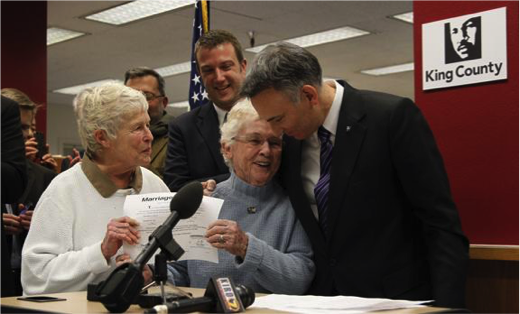Frontline Blog
Showing up for LGBTQ communities
June 2017
By Jesse Chipps, HIV Planning Council Administrator, Public Health – Seattle & King County

June is National Lesbian, Gay, Bisexual and Transgender (LGBT) Pride Month, and each year at this time hundreds of King County employees, department directors and public officials march together in Seattle’s Pride Parade. Rainbow tinsel laden vehicles, bubble machines, and matching t-shirts pull the group together as One King County.
Same sex marriage became legal in Washington State on December 6, 2012, at midnight. While couples who had waited for decades to marry could have waited another few hours until the King County Recorder’s Office opened the next morning, King County Executive Dow Constantine began issuing licenses, personally, at 12:01am.

One of the county’s core values is to be “fair and just” in all we do in order to achieve equitable opportunities for all people and communities. This language was passed into law in 2010 by a unanimous vote of the County Council. The ordinance reflects the values if those who live and work here.
King County is by no means perfect in our efforts to be fair and just, but there is a concerted effort to consider all actions – large and small – through this “equity” lens. Individual departments and the county as a whole are not afraid to take on issues of inequity, whether they are related to race, gender identity, immigration status, income level or ethnicity. For example:
- We changed the gender questions on intake forms at our STD clinic to reflect a wider spectrum of gender identity.
- The County began reaching out to LGBTQ entrepreneurs for inclusion in the County’s directory of small businesses, and tracks the number and size of contracts awarded to these businesses.
- Gender neutral bathrooms were identified and publicized in County buildings.
This dedication to equity for the LGBTQ community extends to our public health efforts as well. Seattle & King County’s HIV/STD Program has worked with scores of community-based agencies, community leaders and the Washington state Department of Health on HIV since the 1980s. We’re thrilled that King County is among the first counties in the country to reach the World Health Organization’s goal of having 90% of all people with HIV know their status, 90% of those diagnosed be on treatment, and 90% of those on treatment be virally suppressed.
HIV is just one of many conditions that disproportionately affect LGBTQ people. In King County, lesbian, gay, and bisexual-identified people are also significantly more likely to smoke tobacco than those who identify as heterosexual. But we only know about this health inequity because Washington State has collected sexual orientation data on the Behavioral Risk Factor Surveillance System (BRFSS) every year since 2003. The Centers for Disease Control (CDC) did not create its own sexual orientation and transgender identity questions for BRFSS until 2016, and those questions are optional. Many states do not ask these questions, or do not do it consistently. A 2014 study by the Fenway Institute showed that between 1995 and 2012, 27 states asked about sexual orientation at least once in BRFSS, and in 2009 13 states and Washington D.C. did so. But collecting information about sexual orientation in health surveys is critically important to understand how LGBTQ may be experiencing health inequities.
There was a brief hope that the federal government was aiming to collect sexual orientation and gender identity information on the Census. Two months ago, the US Census Bureau published, then quickly amended, a document which listed Sexual Orientation and Gender Identity as proposed subjects for the 2020 Census. The National LGBTQ Task Force responded with, “We’ve been ERASED!”
So, on a national level, questions about orientation are not being asked, and are unlikely to be asked anytime soon. Getting the U.S. Census to add these questions and national BRFSS to make their questions part of the core questionnaire is a larger challenge, but there are plenty of local challenges that jurisdictions can take on every day. Here are a few: Dedicate resources towards addressing LGBTQ health disparities. Make sure the bathrooms in your office are safe and welcoming for gender non-conforming staff and clients. And, yes, spend a nice, warm Sunday celebrating your LGBTQ community at Pride.